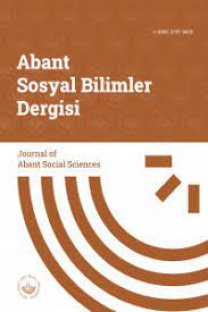FİNANSAL GELİŞME VE YOKSULLUĞUN AZALMASI ARASINDAKİ İLİŞKİ: AMPİRİK BİR İNCELEME
Finansal gelişme, ekonomik büyüme, yoksulluk
___
- Aghion, P., & Bolton, P. (1997). “A Theory of Trickle-Down Growth and Development”. The Review of Economic Studies 64(2): 151–172.
- Akhter, S., Liu, Y., & Daly, K. (2009). “Cross Country Evidence on the Linkages between Financial Development and Poverty”. International Journal of Business and Management 5(1): 3-19.
- Beck, T., Demirgüç-Kunt, A., & Levine, R. (2004). “Finance, Inequality and Poverty: Cross-Country Evidence”. World Bank Policy Research Working Paper 3338.
- Bittencourt, M. (2010). “Financial Development and Inequality: Brazil 1985–1994”. Economic Change and Restructuring, 43(2): 113–130. Claessens, S., & Feijen, E. (2006). “Financial Sector Development and the Millennium Development Goals”. World Bank Working Paper No. 89, World Bank, Washington, DC. Davidson, R., & MacKinnon, J. G. (1993). “Estimation and Inference in Econometrics”. Oxford: Oxford University Press. Dickey, D. A., & Fuller, W. A. (1981). “Likelihood Ratio Statistics for Autoregressive Time Series with a Unit Root”. Econometrica: Journal of the Econometric Society 49(4): 1057–1072. Engle, R. F., & Granger, C. W. (1987). “Co-Integration and Error Correction: Representation, Estimation, and Testing”. Econometrica: Journal of the Econometric Society 55 (2): 251–276. Galor, O., & Tsiddon, D. (1996). “Income Distribution and Growth: The Kuznets Hypothesis Revisited”. Economica, 103–117. Geda, A., Shimeles, A., & Zerfu, D. (2006). “Finance and Poverty in Ethiopia”. UNU-WIDER Research Paper No: 2006/51, United Nations University, Helsinki, Finland. Ho, S.-Y., & Odhiambo, N. M. (2011). “Finance and Poverty Reduction in China: An Empirical Investigation”. International Business & Economics Research Journal (IBER) 10(8): 103–114. Jalilian, H., & Kirkpatrick, C. (2005). “Does Financial Development Contribute to Poverty Reduction?” Journal of Development Studies 41(4): 636–656. Johansen, S., & Juselius, K. (1990). “Maximum Likelihood Estimation and Inference on Cointegration with Applications to the Demand for Money”. Oxford Bulletin of Economics and Statistics 52(2): 169– 210. Kar, M., Agir, H., & Peker, O. (2011). “Financial Development and Poverty Reduction in Turkey”. Department of Economics, Adana, Çukurova University, Turkey. Nelson, C. R., & Plosser, C. R. (1982). “Trends and Random Walks in Macroeconomics Time Series: Some Evidence and Implications”. Journal of Monetary Economics 10(2): 139–162. Odhiambo, N. M. (2009). “Financial Deepening and Poverty Reduction in Zambia: An Empirical Investigation”. International Journal of Social Economics 37(1): 41–53. Odhiambo, N. M. (2010). “Is Financial Development A Spur To Poverty Reduction? Kenya’s Experience”. Journal of Economic Studies 37(3): 343–353. Park, A., Ren, C., & Wang, S. (2004). “Microfinance, Poverty Alleviation, and Financial Reform in China”. Rural Finance and Credit Infrastructure in China, OECD, 256–270. Perotti, R. (1993). “Political Equilibrium, Income Distribution, and Growth”. The Review of Economic Studies 60(4): 755–776. Quartey, P. (2005). “Financial Sector Development, Savings Mobilization and Poverty Reduction in Ghana”. UNU-WIDER Research Paper No: 2005/71, United Nations University, Helsinki, Finland. TCMB Bülten Sayı 34, S. 34. (2014). TCMB Bülten Sayı 34. Türkiye Cumhuriyet Merkez Bankası. Toda, H. Y., & Yamamoto, T. (1995). “Statistical Inference in Vector Autoregressions with Possibly Integrated Processes”. Journal of Econometrics 66(1): 225–250. Uddin, G. S., Shahbaz, M., Arouri, M., & Teulon, F. (2014). “Financial Development and Poverty Reduction Nexus: A Cointegration and Causality Analysis in Bangladesh”. Economic Modelling 36: 405– 412. Zhuang, J., Gunatilake, H. M., Niimi, Y., Khan, M. E., Jiang, Y., Hasan, R., … Huang, B. (2009). “Financial Sector Development, Economic Growth, and Poverty Reduction: A Literature Review”. Asian Development Bank Economics Working Paper Series, (173).
- Yayın Aralığı: Yılda 3 Sayı
- Başlangıç: 2000
- Yayıncı: Abant İzzet Baysal Üniversitesi Sosyal Bilimler Enstitüsü
SPOR YAPAN VE YAPMAYAN BİREYLERİN ÖFKE KONTROL TARZLARININ İNCELENMESİ
Hanifi ÜZÜM, Mustafa ORHAN, Ünal KARLI, Mustafa Kemal DUŞ, Gamze YERLİKAYA, Hulusi GÖKGÖZ
SOSYAL AĞ TÜRLERİNİN KARŞILAŞTIRILMASINA İLİŞKİN BİR AĞ ANALİZİ
Keziban SEÇKİN CODAL, Erman COŞKUN
HEMŞİRELİK ÖĞRENCİLERİNİN TOPLUMSAL CİNSİYET ROLLERİNE İLİŞKİN TUTUMLARI
Meryem AYDIN, Ebru ÖZEN BEKAR, Şerife YILMAZ GÖREN, Mehmet Ali SUNGUR
Bilal ŞİŞMAN, Mesut DOĞAN, Veysel AĞCA
FİNANSAL GELİŞME VE YOKSULLUĞUN AZALMASI ARASINDAKİ İLİŞKİ: AMPİRİK BİR İNCELEME
Muhammet BELEN, Hüseyin KARAMELİKLİ
FEN BİLGİSİ ÖĞRETMEN ADAYLARININ GERİ DÖNÜŞÜM KAVRAMI HAKKINDAKİ FARKINDALIKLARI
BÜTÇE AÇIKLARI ENFLASYONİST ETKİYE SAHİP MİDİR? TÜRKİYE ÜZERİNE UZUN DÖNEMLİ ANALİZ
